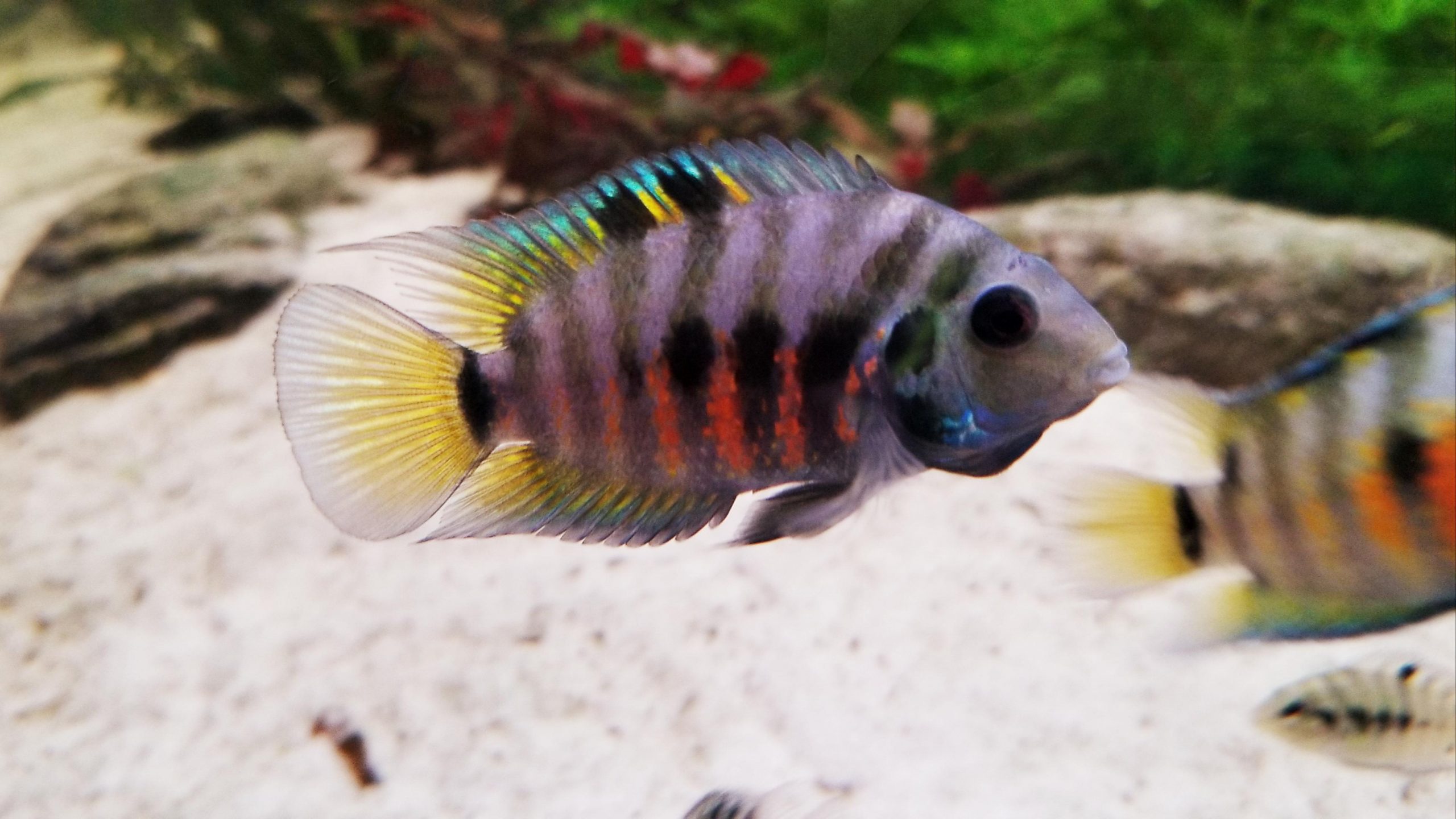Convict Cichlid
The Enduring Appeal of the Convict Cichlid: A Comprehensive Care Guide for the UK Aquarist
Often a gateway species into the vibrant world of cichlids, the Convict Cichlid (Amatitlania nigrofasciata) is a fish that commands attention. With its striking black and grey barring, tenacious personality, and remarkably straightforward care requirements, it has remained a popular choice for aquarists in the United Kingdom for decades. This in-depth guide will provide you with everything you need to know to successfully keep and even breed these fascinating Central American cichlids.
Natural Habitat and Temperament: Understanding the “Convict”
Native to the rivers and streams of Central America, Convict Cichlids are accustomed to a range of water conditions, contributing to their hardiness in the home aquarium. In the wild, they inhabit areas with rocky substrates and submerged wood, which they use for shelter and as spawning sites.
It is this territorial instinct that defines their temperament. While often labelled as “aggressive,” a more accurate description would be “defensive.” They are particularly protective of their chosen territory, a trait that intensifies dramatically during breeding. This behaviour is a key consideration when planning a community aquarium.
Setting Up the Perfect Convict Abode
Creating an appropriate environment is crucial for the well-being of your Convict Cichlids. A well-structured tank will not only make them feel secure but also help to mitigate aggression.
Tank Size
For a single breeding pair of Convict Cichlids, a minimum tank size of 90 litres (approximately 20 gallons) is recommended. However, a larger tank of 120 litres (around 30 gallons) or more is highly advisable, especially if you intend to keep them with other fish. A larger volume of water provides more stable conditions and allows for the creation of distinct territories.
Filtration and Water Parameters
Convict Cichlids are not overly demanding when it comes to water chemistry, but a robust filtration system is essential. They are messy eaters and can produce a significant amount of waste. An external canister filter or a large internal filter with a good flow rate is recommended.
Water Parameter Chart:
| Parameter | Recommended Range |
|---|---|
| Temperature | 24-28°C (75-82°F) |
| pH | 6.5 – 8.0 |
| Hardness (GH) | 8-20 dGH |
| Ammonia (NH3/NH4+) | 0 ppm |
| Nitrite (NO2-) | 0 ppm |
| Nitrate (NO3-) | Below 40 ppm (ideally lower) |
Regular water changes are vital to keep nitrate levels in check. A weekly change of 25-30% is a good routine to follow.
Substrate and Aquascaping
A fine gravel or sand substrate is ideal, as Convict Cichlids enjoy digging, especially when preparing to breed. The aquascape should be rich in hiding places. Use a combination of rocks, caves, and driftwood to create a network of territories. Clay pots turned on their side are also excellent and inexpensive additions that are readily accepted as spawning sites.
Hardy plants such as Anubias, Java Fern, and Amazon Swords can be included, but it is best to attach them to rocks or driftwood to prevent them from being uprooted during the cichlids’ excavations.
A Hearty Appetite: Feeding Your Convict Cichlids
Convict Cichlids are omnivores and have a voracious appetite. A varied diet is key to their health and vitality.
Recommended Diet Breakdown:
- Staple Food: High-quality cichlid pellets or flakes should form the basis of their diet.
- Frozen and Live Foods: Supplement their diet several times a week with frozen or live foods such as brine shrimp, daphnia, bloodworm, and mysis shrimp.
- Vegetable Matter: Offer blanched vegetables like spinach, peas, and courgette to ensure they receive adequate fibre.
Feed your Convict Cichlids once or twice a day, offering only as much food as they can consume within a couple of minutes to avoid overfeeding and water quality issues.
The Prolific Breeders: A Guide to Spawning
One of the most captivating aspects of keeping Convict Cichlids is observing their breeding behaviour. They are prolific and relatively easy to breed in the home aquarium.
Sexing and Pairing
Sexing mature Convict Cichlids is straightforward. Males are typically larger with more pointed dorsal and anal fins. Females are smaller, more rounded, and often display a distinctive orange or reddish-orange colouration on their bellies, which becomes more intense during spawning.
Convicts will often form their own pairs in a group setting. Once a pair has formed, they will become inseparable and will start to claim a territory.
The Spawning Process
The pair will meticulously clean a chosen flat surface, usually a rock or the inside of a cave or pot. The female will then lay her adhesive eggs, which the male will promptly fertilise. Both parents are fiercely protective of their eggs and will diligently guard them against any perceived threats.
The eggs typically hatch within 2-3 days, and the parents will move the wriggling fry to a pre-dug pit in the substrate. The fry will remain in this pit for another few days, absorbing their yolk sacs.
Caring for the Fry
Once the fry become free-swimming, they can be fed newly hatched brine shrimp, microworms, or finely crushed flake food. The parents will continue to care for their young, herding them around the tank and protecting them. It is a remarkable display of parental care in the fish world. As the fry grow, they can be moved to a separate rearing tank to ensure a higher survival rate and to allow the parents to prepare for their next brood.
Community Living: Choosing Tank Mates Wisely
Due to their territorial nature, selecting suitable tank mates for Convict Cichlids requires careful consideration. Any tank mates must be robust and of a similar size and temperament.
Suitable Tank Mates:
- Other Central American Cichlids: Firemouth Cichlids (Thorichthys meeki), Jack Dempseys (Rocio octofasciata), and Green Terrors (Andinoacara rivulatus) can be suitable if the tank is large enough with ample hiding places.
- Larger, Robust Fish: Larger species of Plecostomus (Plecos) and some larger, fast-moving barbs can also co-exist.
Unsuitable Tank Mates:
- Small, Peaceful Fish: Tetras, Guppies, and other small, placid fish will be seen as food and will be quickly consumed.
- Slow-Moving or Long-Finned Fish: These are likely to be harassed and have their fins nipped.
When creating a community with Convict Cichlids, the key is to provide a large and well-structured environment to minimise territorial disputes.
Common Health Concerns
Convict Cichlids are generally hardy fish, but they can be susceptible to common freshwater fish diseases, particularly if water quality is poor.
- Ichthyophthirius multifiliis (Ich/White Spot): This parasitic infection appears as small white spots on the body and fins. It is often triggered by stress or poor water conditions. Treatment typically involves raising the water temperature and using a commercially available white spot remedy.
- Hole-in-the-Head Disease (HITH): This condition, characterised by pits and lesions on the head and lateral line, is often linked to poor water quality, nutritional deficiencies, or the presence of the parasite Hexamita. Improving diet and water quality is the first line of defence.
- Fin Rot: Bacterial infections can cause the fins to appear ragged and frayed. This is almost always a result of poor water conditions and can be treated with antibacterial medications.
The best way to prevent disease is to maintain excellent water quality, provide a balanced diet, and avoid overcrowding.
The Enduring Inmate of the Aquarium
The Convict Cichlid, with its bold stripes and even bolder personality, offers a rewarding experience for the dedicated aquarist. By understanding their natural behaviours and providing an environment that caters to their needs, you can enjoy the fascinating dynamics of this classic cichlid for years to come. Their ease of care and captivating breeding habits ensure they will remain a firm favourite in the UK fishkeeping hobby.


